height Hyundai Tiburon 2004 Owner's Manual
[x] Cancel search | Manufacturer: HYUNDAI, Model Year: 2004, Model line: Tiburon, Model: Hyundai Tiburon 2004Pages: 224, PDF Size: 18.86 MB
Page 24 of 224
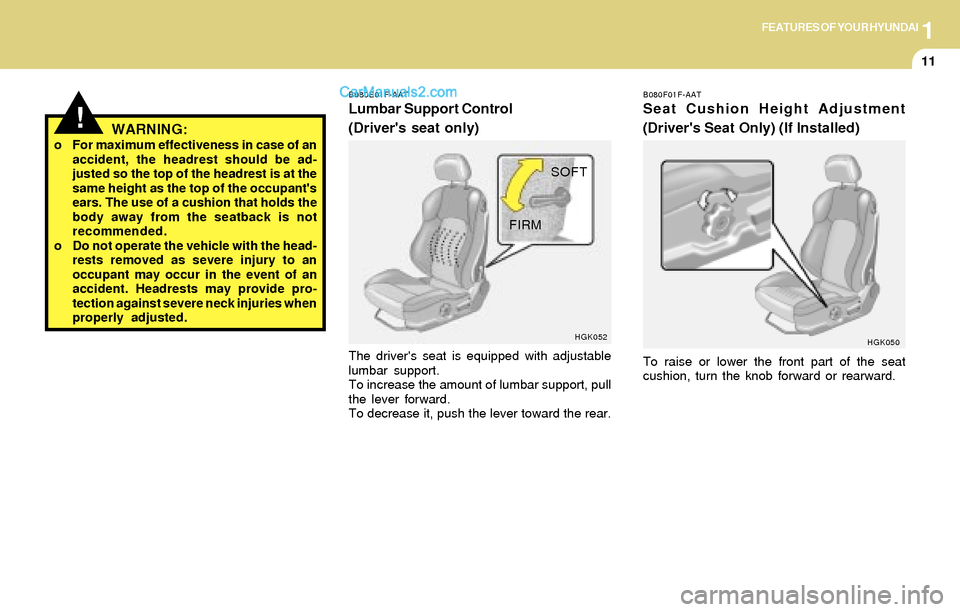
1FEATURES OF YOUR HYUNDAI
11
!WARNING:o For maximum effectiveness in case of an
accident, the headrest should be ad-
justed so the top of the headrest is at the
same height as the top of the occupant's
ears. The use of a cushion that holds the
body away from the seatback is not
recommended.
o Do not operate the vehicle with the head-
rests removed as severe injury to an
occupant may occur in the event of an
accident. Headrests may provide pro-
tection against severe neck injuries when
properly adjusted.
B080E01F-AAT
Lumbar Support Control
(Driver's seat only)
The driver's seat is equipped with adjustable
lumbar support.
To increase the amount of lumbar support, pull
the lever forward.
To decrease it, push the lever toward the rear.SOFT
HGK052
FIRM
B080F01F-AAT
Seat Cushion Height Adjustment
(Driver's Seat Only) (If Installed)
To raise or lower the front part of the seat
cushion, turn the knob forward or rearward.
HGK050
Page 28 of 224

1FEATURES OF YOUR HYUNDAI
15
!
The restraint must be appropriate for your
child's height and weight. Check the label
on the child restraint for this information.
See page 1-19.
B150C02A-AAT
Larger Children
Children who are too large for child restraint
systems should always occupy the rear seat
and use the available lap/shoulder belts. The lap
portion should be fastened snug on the hips and
as low as possible. Check belt fit periodically. A
child's squirming could put the belt out of posi-
tion. Children are afforded the most safety in the
event of an accident when they are restrained
by a proper restraint system in the rear seat. If
a larger child (over age 13) must be seated in
the front seat, the child should be securely
restrained by the available lap/shoulder belt and
the seat should be placed in the rearmost
position. Children under the age of 13 should be
restrained securely in the rear seat. Never
place a child under the age of 13 in the front seat.
NEVER place a rear facing child seat in the front
seat of a vehicle.
B150D01A-AAT
Pregnant Women
The use of a seat belt is recommended for
pregnant women to lessen the chance of injury
in an accident. When a seat belt is used, the lap
belt portion should be placed as low and snugly
as possible on the hips, not across the abdo-
men. For specific recommendations, consult a
physician.
B150E01A-AATInjured Person
A seat belt should be used when an injured
person is being transported. When this is nec-
essary, you should consult a physician for
recommendations.
B150F01A-AATOne Person Per Belt
Two people (including children) should never
attempt to use a single seat belt. This could
increase the severity of injuries in case of an
accident.
B150G01A-AAT
Do Not Lie Down
To reduce the chance of injuries in the event of
an accident and to achieve maximum effective-
ness of the restraint system, all passengers
should be sitting up and the front seats should
be in an upright position when the car is moving.
A seat belt cannot provide proper protec-tion if
the person is lying down in the rear seat or if the
front seat is in a reclined position.
WARNING:Sitting in a reclined position or lying down
when your vehicle is in motion can be
dangerous. Even if you buckle up, your seat
belts can't do their job when you're re-
clined.
The shoulder belt can't do its job because
it won't be against your body.
Instead, it will be in front of you. In a crash
you could go into it with great force, receiv-
ing serious neck or other injuries.
The lap belt can't do its job either. In a crash
the belt could go up over your abdomen.
The belt forces would be applied there, not
at your strong pelvic bones.
This could cause serious internal injuries.
For proper protection when the vehicle is in
motion, have the seatback upright.
Then sit back in the seat and wear your seat
belt properly. See page 1-17.
Page 29 of 224
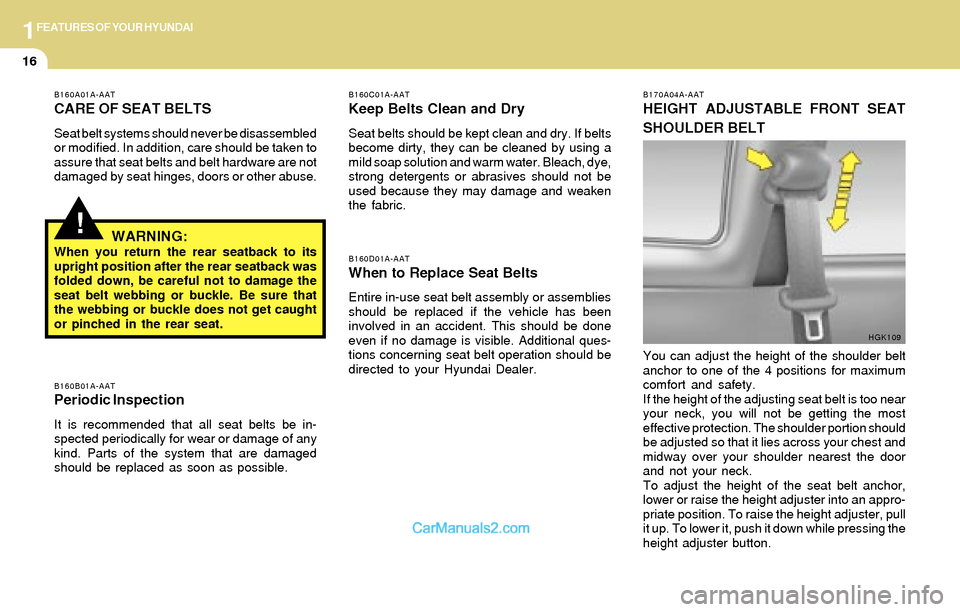
1FEATURES OF YOUR HYUNDAI
16
B170A04A-AAT
HEIGHT ADJUSTABLE FRONT SEAT
SHOULDER BELT
You can adjust the height of the shoulder belt
anchor to one of the 4 positions for maximum
comfort and safety.
If the height of the adjusting seat belt is too near
your neck, you will not be getting the most
effective protection. The shoulder portion should
be adjusted so that it lies across your chest and
midway over your shoulder nearest the door
and not your neck.
To adjust the height of the seat belt anchor,
lower or raise the height adjuster into an appro-
priate position. To raise the height adjuster, pull
it up. To lower it, push it down while pressing the
height adjuster button.
HGK109 B160C01A-AAT
Keep Belts Clean and Dry
Seat belts should be kept clean and dry. If belts
become dirty, they can be cleaned by using a
mild soap solution and warm water. Bleach, dye,
strong detergents or abrasives should not be
used because they may damage and weaken
the fabric.
B160D01A-AATWhen to Replace Seat Belts
Entire in-use seat belt assembly or assemblies
should be replaced if the vehicle has been
involved in an accident. This should be done
even if no damage is visible. Additional ques-
tions concerning seat belt operation should be
directed to your Hyundai Dealer.
!
B160A01A-AAT
CARE OF SEAT BELTS
Seat belt systems should never be disassembled
or modified. In addition, care should be taken to
assure that seat belts and belt hardware are not
damaged by seat hinges, doors or other abuse.
WARNING:When you return the rear seatback to its
upright position after the rear seatback was
folded down, be careful not to damage the
seat belt webbing or buckle. Be sure that
the webbing or buckle does not get caught
or pinched in the rear seat.
B160B01A-AATPeriodic Inspection
It is recommended that all seat belts be in-
spected periodically for wear or damage of any
kind. Parts of the system that are damaged
should be replaced as soon as possible.
Page 30 of 224
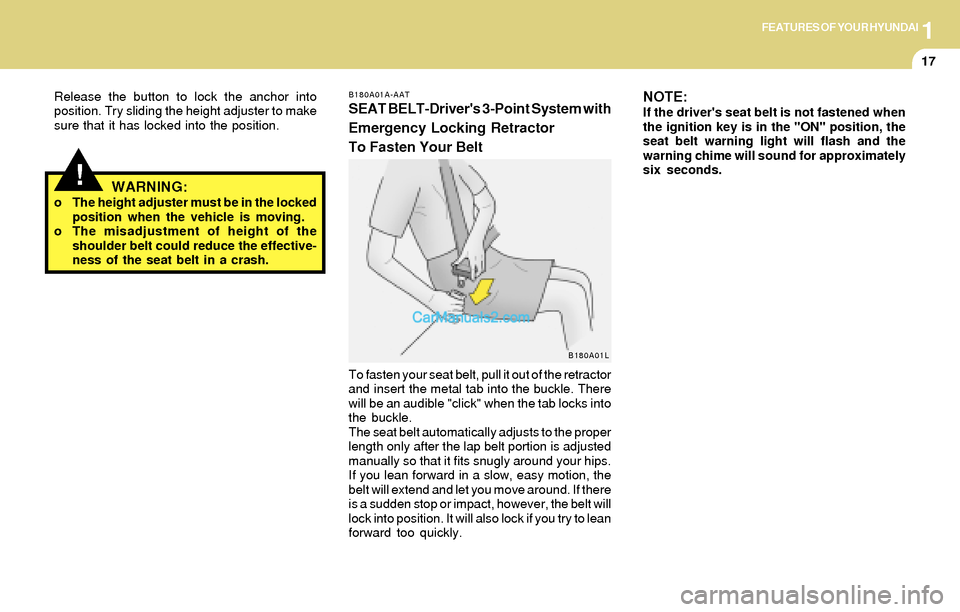
1FEATURES OF YOUR HYUNDAI
17
!
Release the button to lock the anchor into
position. Try sliding the height adjuster to make
sure that it has locked into the position.
WARNING:o The height adjuster must be in the locked
position when the vehicle is moving.
o The misadjustment of height of the
shoulder belt could reduce the effective-
ness of the seat belt in a crash.
B180A01A-AAT
SEAT BELT-Driver's 3-Point System with
Emergency Locking Retractor
To Fasten Your Belt
To fasten your seat belt, pull it out of the retractor
and insert the metal tab into the buckle. There
will be an audible "click" when the tab locks into
the buckle.
The seat belt automatically adjusts to the proper
length only after the lap belt portion is adjusted
manually so that it fits snugly around your hips.
If you lean forward in a slow, easy motion, the
belt will extend and let you move around. If there
is a sudden stop or impact, however, the belt will
lock into position. It will also lock if you try to lean
forward too quickly.
B180A01L
NOTE:If the driver's seat belt is not fastened when
the ignition key is in the "ON" position, the
seat belt warning light will flash and the
warning chime will sound for approximately
six seconds.
Page 33 of 224
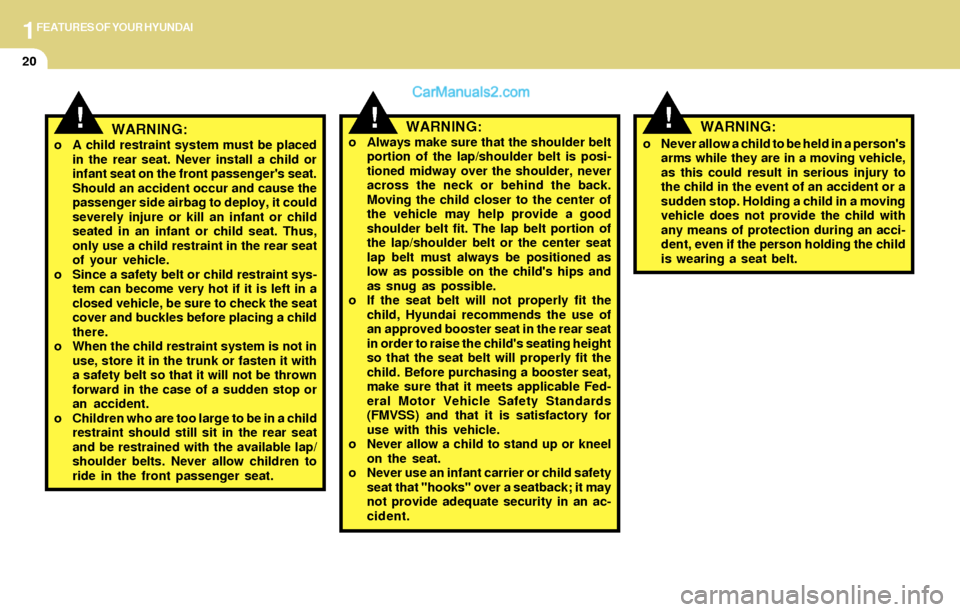
1FEATURES OF YOUR HYUNDAI
20
!!
o Always make sure that the shoulder belt
portion of the lap/shoulder belt is posi-
tioned midway over the shoulder, never
across the neck or behind the back.
Moving the child closer to the center of
the vehicle may help provide a good
shoulder belt fit. The lap belt portion of
the lap/shoulder belt or the center seat
lap belt must always be positioned as
low as possible on the child's hips and
as snug as possible.
o If the seat belt will not properly fit the
child, Hyundai recommends the use of
an approved booster seat in the rear seat
in order to raise the child's seating height
so that the seat belt will properly fit the
child. Before purchasing a booster seat,
make sure that it meets applicable Fed-
eral Motor Vehicle Safety Standards
(FMVSS) and that it is satisfactory for
use with this vehicle.
o Never allow a child to stand up or kneel
on the seat.
o Never use an infant carrier or child safety
seat that "hooks" over a seatback; it may
not provide adequate security in an ac-
cident.o Never allow a child to be held in a person's
arms while they are in a moving vehicle,
as this could result in serious injury to
the child in the event of an accident or a
sudden stop. Holding a child in a moving
vehicle does not provide the child with
any means of protection during an acci-
dent, even if the person holding the child
is wearing a seat belt.WARNING: WARNING:!WARNING:o A child restraint system must be placed
in the rear seat. Never install a child or
infant seat on the front passenger's seat.
Should an accident occur and cause the
passenger side airbag to deploy, it could
severely injure or kill an infant or child
seated in an infant or child seat. Thus,
only use a child restraint in the rear seat
of your vehicle.
o Since a safety belt or child restraint sys-
tem can become very hot if it is left in a
closed vehicle, be sure to check the seat
cover and buckles before placing a child
there.
o When the child restraint system is not in
use, store it in the trunk or fasten it with
a safety belt so that it will not be thrown
forward in the case of a sudden stop or
an accident.
o Children who are too large to be in a child
restraint should still sit in the rear seat
and be restrained with the available lap/
shoulder belts. Never allow children to
ride in the front passenger seat.
Page 130 of 224
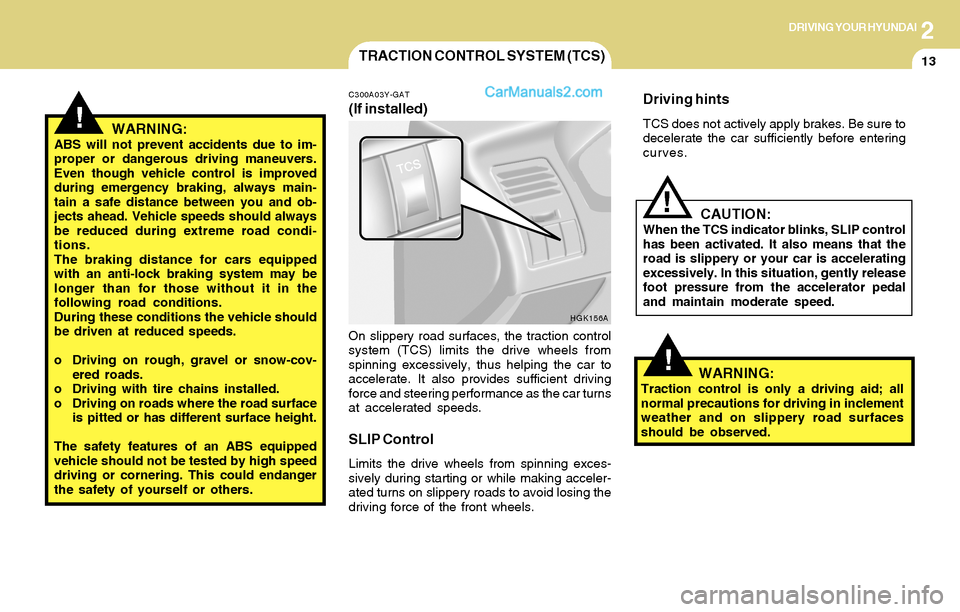
2DRIVING YOUR HYUNDAI
13TRACTION CONTROL SYSTEM (TCS)
!
!WARNING:ABS will not prevent accidents due to im-
proper or dangerous driving maneuvers.
Even though vehicle control is improved
during emergency braking, always main-
tain a safe distance between you and ob-
jects ahead. Vehicle speeds should always
be reduced during extreme road condi-
tions.
The braking distance for cars equipped
with an anti-lock braking system may be
longer than for those without it in the
following road conditions.
During these conditions the vehicle should
be driven at reduced speeds.
o Driving on rough, gravel or snow-cov-
ered roads.
o Driving with tire chains installed.
o Driving on roads where the road surface
is pitted or has different surface height.
The safety features of an ABS equipped
vehicle should not be tested by high speed
driving or cornering. This could endanger
the safety of yourself or others.
C300A03Y-GAT
(If installed)
On slippery road surfaces, the traction control
system (TCS) limits the drive wheels from
spinning excessively, thus helping the car to
accelerate. It also provides sufficient driving
force and steering performance as the car turns
at accelerated speeds.
SLIP Control
Limits the drive wheels from spinning exces-
sively during starting or while making acceler-
ated turns on slippery roads to avoid losing the
driving force of the front wheels.
Driving hints
TCS does not actively apply brakes. Be sure to
decelerate the car sufficiently before entering
curves.
CAUTION:When the TCS indicator blinks, SLIP control
has been activated. It also means that the
road is slippery or your car is accelerating
excessively. In this situation, gently release
foot pressure from the accelerator pedal
and maintain moderate speed.
WARNING:Traction control is only a driving aid; all
normal precautions for driving in inclement
weather and on slippery road surfaces
should be observed.
HGK156A
!
Page 146 of 224
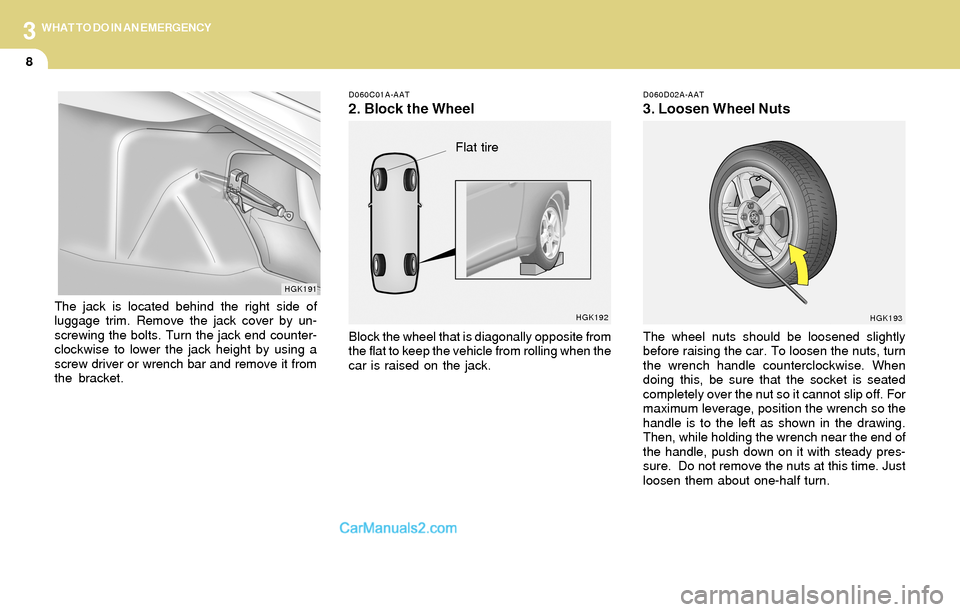
3
8
WHAT TO DO IN AN EMERGENCY
D060C01A-AAT
2. Block the Wheel
Block the wheel that is diagonally opposite from
the flat to keep the vehicle from rolling when the
car is raised on the jack.
HGK192
Flat tire
D060D02A-AAT
3. Loosen Wheel Nuts
The wheel nuts should be loosened slightly
before raising the car. To loosen the nuts, turn
the wrench handle counterclockwise. When
doing this, be sure that the socket is seated
completely over the nut so it cannot slip off. For
maximum leverage, position the wrench so the
handle is to the left as shown in the drawing.
Then, while holding the wrench near the end of
the handle, push down on it with steady pres-
sure. Do not remove the nuts at this time. Just
loosen them about one-half turn.
HGK193The jack is located behind the right side of
luggage trim. Remove the jack cover by un-
screwing the bolts. Turn the jack end counter-
clockwise to lower the jack height by using a
screw driver or wrench bar and remove it from
the bracket.
HGK191
Page 216 of 224
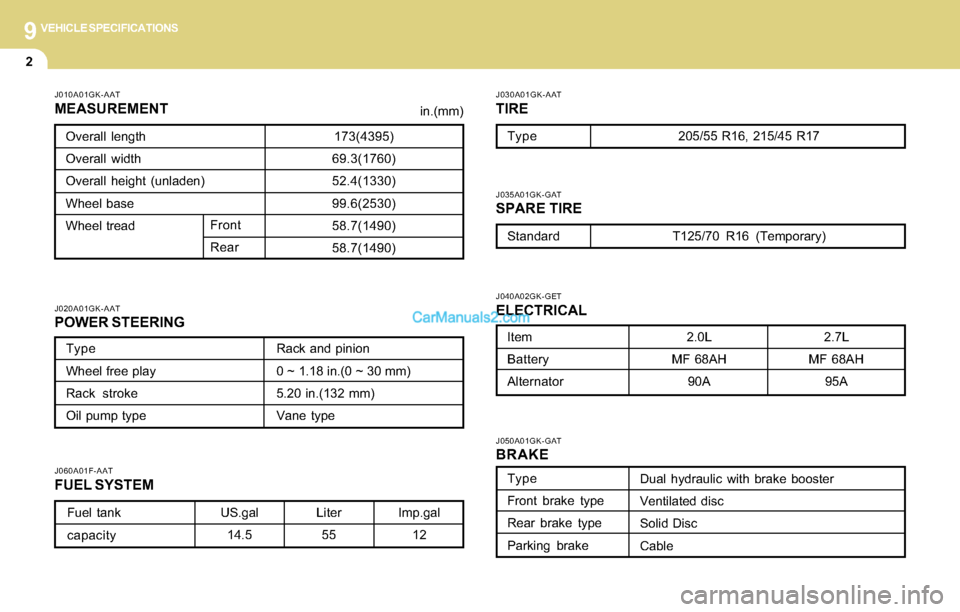
9VEHICLE SPECIFICATIONS
2
J050A01GK-GATBRAKE
J040A02GK-GET
ELECTRICAL
J030A01GK-AAT
TIRE
J060A01F-AATFUEL SYSTEM
J020A01GK-AATPOWER STEERING
J010A01GK-AAT
MEASUREMENT
173(4395)
69.3(1760)
52.4(1330)
99.6(2530)
58.7(1490)
58.7(1490) Overall length
Overall width
Overall height (unladen)
Wheel base
Wheel tread
Front
Rear
Type
Wheel free play
Rack stroke
Oil pump typeRack and pinion
0 ~ 1.18 in.(0 ~ 30 mm)
5.20 in.(132 mm)
Vane type
Liter
55Fuel tank
capacity
Type205/55 R16, 215/45 R17
Item
Battery
Alternator
US.gal
14.5
in.(mm)
Imp.gal
12
J035A01GK-GATSPARE TIRE
StandardT125/70 R16 (Temporary)
2.0L
MF 68AH
90A2.7L
MF 68AH
95A
Type
Front brake type
Rear brake type
Parking brake
Dual hydraulic with brake booster
Ventilated disc
Solid Disc
Cable
Page 221 of 224

10INDEX
3
D
Defrosting/Defogging........................................................................1-69
Door
Central door lock............................................................................ 1-5
Door locks...................................................................................... 1-4
Front door edge warning light ......................................................1-53
Locking, unlocking front door with a key ...................................... 1-4
Drink Holder ......................................................................................1-47
Drive Belts.............................................................................. 6-18, 6-20
Driving
Economical driving .......................................................................2-14
Smooth cornering.........................................................................2-15
Winter driving...............................................................................2-16
E
Emissions Control Systems............................................................... 7-2
Engine
Before starting the engine .............................................................. 2-3
Compartment................................................................................. 6-2
Coolant........................................................................................... 6-7
Coolant temperature gauge .........................................................1-38
If the engine overheats .................................................................. 3-4
Number........................................................................................... 8-2
Oil ................................................................................................... 6-5
Starting........................................................................................... 2-4
Engine Exhaust Can Be Dangerous .................................................. 2-2F
Floor mat Anchor ..............................................................................1-58
Front Fog Light Switch ......................................................................1-53
Front Seats
Adjustable front seats.................................................................... 1-9
Adjustable headrests...................................................................1-10
Adjusting seatback angle .............................................................1-10
Adjusting seat forward and rearward ............................................ 1-9
Lumbar support control ...............................................................1-11
Seat cushion height adjustment ..................................................1-11
Fuel
Capacity......................................................................................... 9-2
Gauge...........................................................................................1-37
Recommendations......................................................................... 1-2
Fuel Filler Lid
Remote release............................................................................1-54
Fuses................................................................................................6-21
Fuse Panel Description ...............................................................6-32
G
General Everyday Checks................................................................. 6-4
Glove box ..........................................................................................1-50
H
Hazard Warning System ..................................................................1-44
Headlight Aiming Adjustment ............................................................6-25
Headlight Bulb....................................................................................6-26
Page 222 of 224
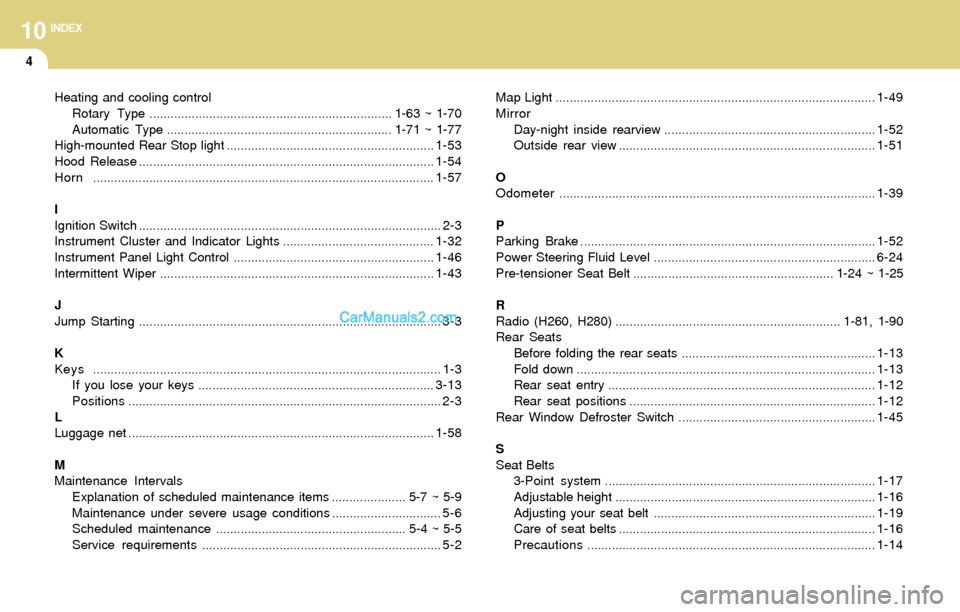
10INDEX
4
Heating and cooling control
Rotary Type..................................................................... 1-63 ~ 1-70
Automatic Type ................................................................ 1-71 ~ 1-77
High-mounted Rear Stop light ...........................................................1-53
Hood Release....................................................................................1-54
Horn.................................................................................................1-57
I
Ignition Switch ...................................................................................... 2-3
Instrument Cluster and Indicator Lights...........................................1-32
Instrument Panel Light Control .........................................................1-46
Intermittent Wiper..............................................................................1-43
J
Jump Starting...................................................................................... 3-3
K
Keys................................................................................................... 1-3
If you lose your keys ...................................................................3-13
Positions......................................................................................... 2-3
L
Luggage net.......................................................................................1-58
M
Maintenance Intervals
Explanation of scheduled maintenance items ..................... 5-7 ~ 5-9
Maintenance under severe usage conditions............................... 5-6
Scheduled maintenance...................................................... 5-4 ~ 5-5
Service requirements.................................................................... 5-2Map Light...........................................................................................1-49
Mirror
Day-night inside rearview ............................................................1-52
Outside rear view .........................................................................1-51
O
Odometer..........................................................................................1-39
P
Parking Brake....................................................................................1-52
Power Steering Fluid Level ...............................................................6-24
Pre-tensioner Seat Belt......................................................... 1-24 ~ 1-25
R
Radio (H260, H280)................................................................ 1-81, 1-90
Rear Seats
Before folding the rear seats .......................................................1-13
Fold down.....................................................................................1-13
Rear seat entry ............................................................................1-12
Rear seat positions......................................................................1-12
Rear Window Defroster Switch ........................................................1-45
S
Seat Belts
3-Point system.............................................................................1-17
Adjustable height..........................................................................1-16
Adjusting your seat belt ...............................................................1-19
Care of seat belts .........................................................................1-16
Precautions..................................................................................1-14